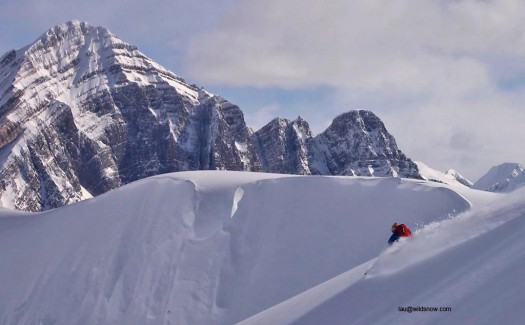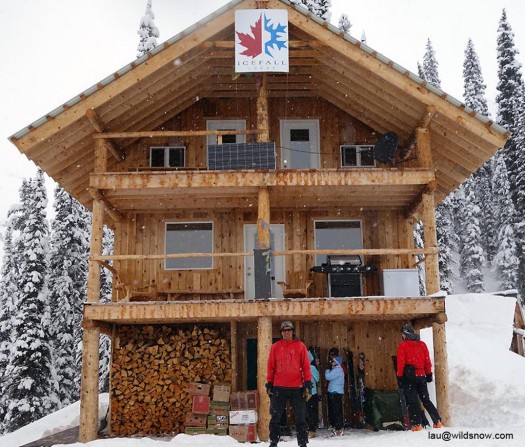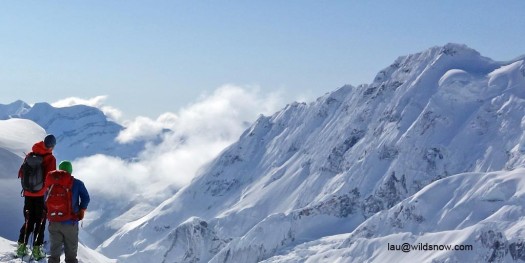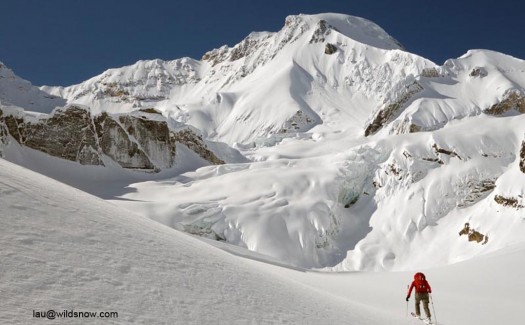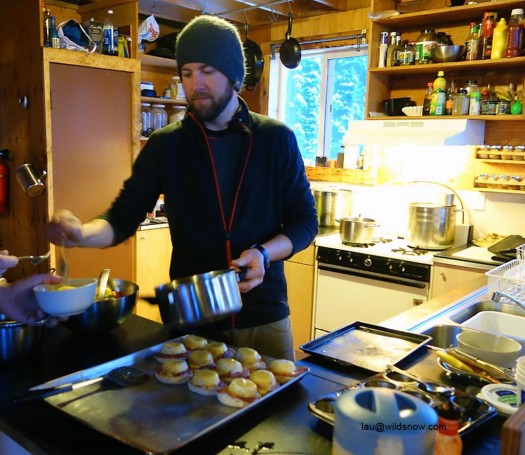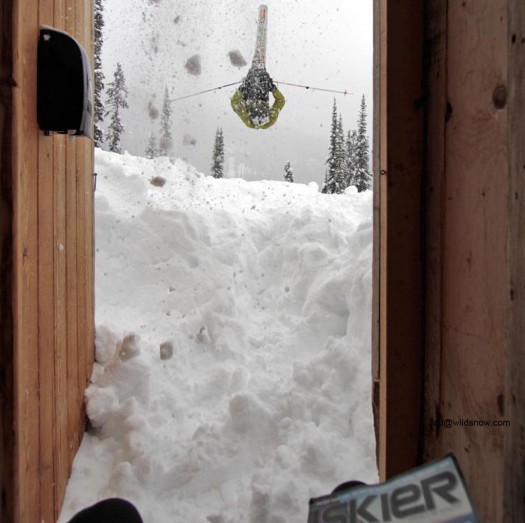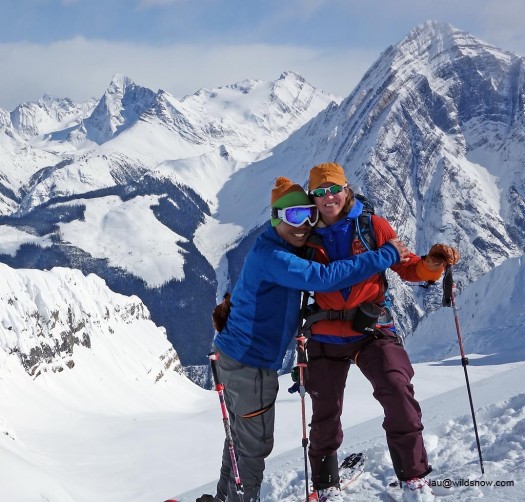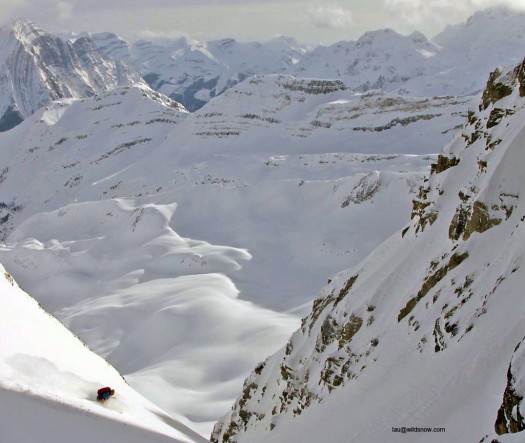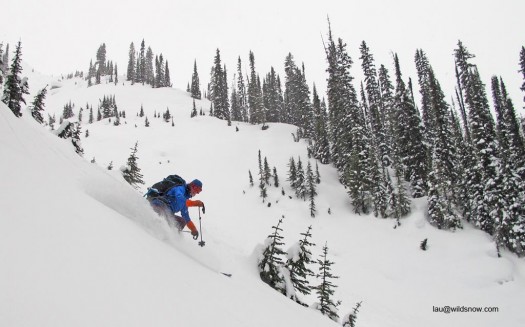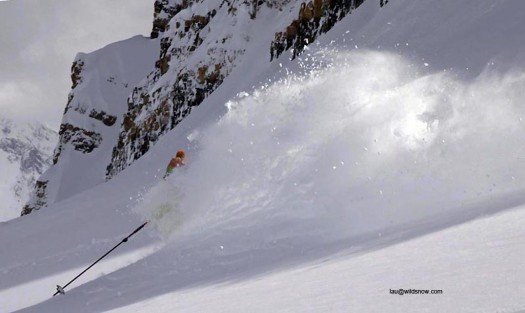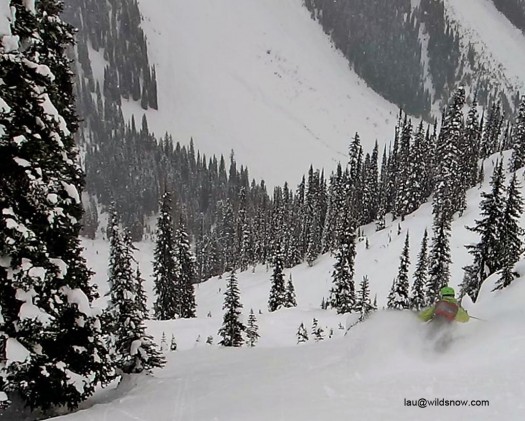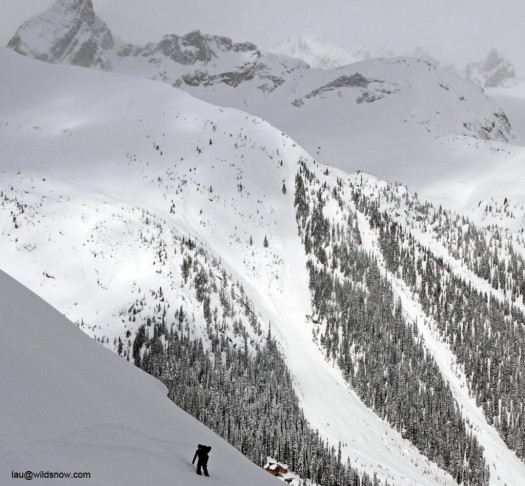There are many commercial backcountry ski-touring huts in Canada. Most of them are located in the interior of British Columbia (see our Backcountry Lodges banner in right column). Not all are created the same. Some are older, some are newer. Many are available only fully guided and catered while some allow anyone to book them. The one common thing they all offer is the dream of untracked light powder snow with a lack of crowds.
My wife Sharon and I have gone to Icefall Lodge twice in the last two years which speaks volumes about our high opinion of the area. The eye on the prize for us is terrain; preferably big glaciated terrain with ski lines on all aspects. A healthy dose of good tree-skiing is always appreciated, but since we have no shortage of that in our local haunts in the BC Coast, we crave the alpine lines.
Icefall Lodge is a 30 minute helicopter ride from the TransCanada Highway just north of Golden, British Columbia. Golden itself is 7 hours east of Vancouver and 3 hours west of Calgary. The namesake lodge is located at an elevation of about 1950m (100m short of sub-alpine) on a knoll surrounded by 400m treed runs. Within a days trip of a group with reasonable range there are 3000m peaks, no less than 7 named glaciers (and several that are un-named), runs that drop 1200m or more all the way to valley floor; and two other satellite lodges. To sum it up, Icefall Lodge’s distinguishing feature differentiating it from many other lodges is that it offers insane alpine terrain in a setting where you can be unguided.
Icefall’s geographical location is not a coincidence. It is located on the western side of the Canadian Rockies. Moisture-laden storms come in from the west and annihilate west-facing slopes in this part of the world coating them with pow. This happy chance means that Icefall gets a significant amount more snow than the often-dry central and eastern slopes of that range. Ranges further west tend to get more snow than those east. In order of total precipitation/snowfall totals the rank goes Monashees – Selkirks – Rockies (declining).
This trip took place at a prime time, during the third week of March. This time of the year is characterized by fat snowpacks (well snow-bridged glaciers and increasingly better stability), long days and good weather.
Our group consisted of 18 people including a cook – Calder Graham of Mo’s Mountain Cuisine, who cheerfully and capably fed us all week. The previous week’s pineapple express had eradicated skiing at low elevations by depositing rain on the snowpack. It left us with good travel conditions and lots of storm snow above the freezing level of approx 1500m. We dealt with a customary snowpack for that region for that time of the year which meant we ran the gamut of wind transport, good (but not excellent) coverage, some persistent weak layers and light snow with temperatures in the minus 8 to 15 degrees C during the day.
Larry Dolecki is a mountain guide and the man behind Icefall Lodge. Larry started out tromping around glaciers in high school during summers. His interest grew and he switched to skiing, eventually becoming a guide in 1993. He first saw this area in fall 2003 when he drove up a logging road. After a lot more hiking and obsessing, Larry applied for tenure in 2005 and built a basic hut at the main Icefall Lodge location. Since then he’s built another hut at the main location as well as the Mons and the Lyell Hut thus allowing hut-to-hut traverses. Now a dad, Larry’s had his daughter out to Icefall a few times and plans to keep running it as a “dream business” allowing him to spend a lot of time in the mountains and still make a living.
Since we’ve never stayed at the other huts comments are only to the main lodge and its satellite building. 18 people are housed comfortably at Icefall Lodge. The main lodge itself is fairly industrial just being four walls and two floors for the most part with a huge drying room and gear prep area on the ground floor. The main floor is roomy with lots of space for stretching and is dominated by the kitchen area with two seating areas for eating and chilling. The upstairs (third floor) has the bedrooms.
The satellite lodge to Icefall is actually the first structure that was built. With two floors it’s arranged with a lounge at the bottom and sleeping arrangements at the top but has luxurious couches on which to hang out (which the main lodge lacks). Both buildings in Icefall have power via a generator. You can have hot water showers and also clean up in a sauna. Water is pumped from a nearby creek. There is satellite internet with enough bandwidth to check emails or get weather reports. You can also get weather via the Icefall repeater if you make arrangements beforehand with Chatter Creek (the boys over there like their beer so show your appreciation by bringing some over).
One look at Icefall Lodge’s run map is guaranteed to blow your mind. It shows all the potential lines in the area; the scale and possibilities beggar imagination. After being to Icefall twice we still haven’t scratched the surface. Simply put, Icefall’s terrain is huge, enormous, gargantuan. There are skiable aspects on all points of the compass. There are look-at-me movie bro lines down huge open faces. There are tight couloirs so one can get booting if that takes your fancy. There are fluted spines where it doesn’t seem right that snow should stick. There are light powdery faces next to glistening blue-iced seracs. There are treed shots further than the eyes can see – again on all manner of aspects. Frankly the only knock against the terrain is that there are almost too many choices; almost lending itself to paralysis by analysis.
There is a fairly large amount of terrain in close proximity to Icefall Lodge itself so it is entirely possible for a large group to split up and tackle different objectives; which is what we did most days. It should be noted that many of the alpine objectives have longish approaches and extensive glaciation so parties should plan and equip themselves accordingly. Icefall Lodge itself is on a densely treed knob that’s well-protected from the elements. It is possible to start your day with a descent down a mellow gladed treed run but most days we chose to start with a climb and then descend back to the lodge at end of the day.
Dates and pricing availability for Icefall Lodge are here. Based on an eighteen person group (including our cook) we paid $1400 per person. It will be less in 2013-14 as taxes are lower. Adding a cook added about $250 per person. For us it’s an easy decision to add a cook since we eat at least $150 a week in food if touring.
For more information about ski touring in the Selkirks or the Columbia Mountains generally check out Summits & Icefields 2: Alpine Ski Tours in the Columbia Mountains.
Chic Scott’s seminal guide Summits & Icefields 1: Alpine Ski Tours in the Canadian Rockies.
Its sister book Alpine Ski Tours in the Columbia Mountains: Summits & Icefields.
.
Guest blogger Lee Lau is an avid skier and outdoorsman embarking on many adventures with his loving, and sometimes concerned wife, Sharon. He has over 15 years of experience skiing, ski-touring and dabbles in mountaineering. In the “off-season” he is occasionally found working in his day job as an intellectual property lawyer when he is not mountain biking. As a resident of Vancouver, British Columbia, Lee’s playground extends mainly to Western Canada, including South West B.C. and the Selkirks.

